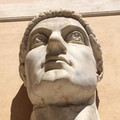的点评
Masters of the Months & the St George Tapestries. +++++
Museo della Cattedrale的点评
点评:After seeing the very impressive exterior of the Cathedral, with its multiple loggias and beautifully sculpted portals, and then being a bit disappointed by the offerings inside the Cathedral (the interior was destroyed in a fire in the 18th century and rebuilt), one might be hesitant to visit the Museo della Cattedrale, the repository of art from within the Cathedral. Do not pause.. the Museo is definitely worth the visit. Here there are two cycles, both masterworks, in different media, that are must visits.
The first of the cycles as you enter the museum are by the Master of the Mo
nths of Ferrara, a sculptor who in the year 1230 created thirteen panels (one for each month and a Grape Harvest) depicting the activities of each month of the year. The Gothic naturalism in the panels is wonderful. In January and February, the Master evoke winter with the character's footwear, with hanging sausage, and a cauldron in which black pudding boils. In September, the harvester of the grapes wears a cap to protect his hair, a vein distends as he holds the heavy basket full of grapes. A wonderful group that displays an uncommon side of the Gothic.
The second cycle is a series of eight huge tapestries (each 14 feet by 15 feet) depicting scenes from the life of St George and St. Maurelius, both martyrs. The Renaissance tapestries, quite realistic in staging the deaths of he martyrs, are the only series of cloths woven in Ferrara during the Renaissance that has been preserved in their entirety, it was made by the Flemish tapestry maker Johannes Karcher, who worked at the Este court, where he served until the death of Ercole II in 1559.
The first of the cycles as you enter the museum are by the Master of the Mo
nths of Ferrara, a sculptor who in the year 1230 created thirteen panels (one for each month and a Grape Harvest) depicting the activities of each month of the year. The Gothic naturalism in the panels is wonderful. In January and February, the Master evoke winter with the character's footwear, with hanging sausage, and a cauldron in which black pudding boils. In September, the harvester of the grapes wears a cap to protect his hair, a vein distends as he holds the heavy basket full of grapes. A wonderful group that displays an uncommon side of the Gothic.
The second cycle is a series of eight huge tapestries (each 14 feet by 15 feet) depicting scenes from the life of St George and St. Maurelius, both martyrs. The Renaissance tapestries, quite realistic in staging the deaths of he martyrs, are the only series of cloths woven in Ferrara during the Renaissance that has been preserved in their entirety, it was made by the Flemish tapestry maker Johannes Karcher, who worked at the Este court, where he served until the death of Ercole II in 1559.
翻译:在看到大教堂令人印象深刻的外观、多个凉廊和雕刻精美的门廊,然后对大教堂内部的供品感到有些失望(内部在 18 世纪的一场大火中被摧毁,后来重建),人们可能会犹豫是否要参观大教堂内部艺术品的博物馆。不要犹豫……博物馆绝对值得一游。这里有两个系列,都是杰作,采用不同的媒介,是必看的。
进入博物馆后,第一个系列是费拉拉月之主的作品,他是一位雕塑家,在 1230 年创作了 13 幅面板(每个月一幅,还有一幅葡萄收获),描绘了一年中每个月的活动。面板上的哥特式自然主义非常精彩。一月和二月,大师用角色的鞋子、挂着的香肠和煮黑布丁的大锅唤起冬天的气息。九月,葡萄收割者戴上帽子保护头发,当他拿着装满葡萄的沉重篮子时,静脉膨胀了。这组精彩的作品展示了哥特式建筑不寻常的一面。
第二个周期是一系列八幅巨大的挂毯(每幅 14 英尺 x 15 英尺),描绘了两位殉道者圣乔治和圣毛里利乌斯的生活场景。文艺复兴时期的挂毯非常逼真地展现了殉道者的死亡,是文艺复兴时期在费拉拉编织的唯一一套完整保存的布料,它是由佛兰芒挂毯制作师约翰内斯·卡切尔制作的,他在埃斯特宫廷工作,直到 1559 年埃尔科莱二世去世。
进入博物馆后,第一个系列是费拉拉月之主的作品,他是一位雕塑家,在 1230 年创作了 13 幅面板(每个月一幅,还有一幅葡萄收获),描绘了一年中每个月的活动。面板上的哥特式自然主义非常精彩。一月和二月,大师用角色的鞋子、挂着的香肠和煮黑布丁的大锅唤起冬天的气息。九月,葡萄收割者戴上帽子保护头发,当他拿着装满葡萄的沉重篮子时,静脉膨胀了。这组精彩的作品展示了哥特式建筑不寻常的一面。
第二个周期是一系列八幅巨大的挂毯(每幅 14 英尺 x 15 英尺),描绘了两位殉道者圣乔治和圣毛里利乌斯的生活场景。文艺复兴时期的挂毯非常逼真地展现了殉道者的死亡,是文艺复兴时期在费拉拉编织的唯一一套完整保存的布料,它是由佛兰芒挂毯制作师约翰内斯·卡切尔制作的,他在埃斯特宫廷工作,直到 1559 年埃尔科莱二世去世。
此点评仅代表旅行者个人的主观意见,并不代表TripAdvisor以及其合作方的意见。
关于我们
|
新闻动态
|
商务合作
|
会员中心
|
业主中心
|
业主通
|
常见问题
|
意见反馈
|
联系我们
|
营业执照
© 2025 Tripadvisor 版权所有。
使用条款 |隐私政策 |网站工作原理
部分照片由 VFM Leonardo 提供。
* Tripadvisor不是旅行社,也不是旅游预订服务代理商。我们提供免费、客观、公正的旅游资讯服务。 (显示更多)
TripAdvisor LLC 既不是预订代理商,也不是旅游运营商,不会向网站用户收取任何服务费。 按照规定,在 Tripadvisor 发布机票价格、游览和旅行套餐的合作伙伴(航空公司、旅行提供商及预订代理商),其标价须包含所有费用和附加费用。 例如, 机场出入境税费、消费税与其他服务费、手续费、杂费及附加费用。 当您向我们的某个合作伙伴进行预订时,请务必查阅他们的网站以了解当地行政部门要求的所有适用费用的具体情况。 除非另有说明,机票价格通常指的是一个人的价格(以人民币计)。
为方便起见,TripAdvisor LLC 根据从我们的预订合作伙伴获取的空房率计算每个酒店的均价。 对于游览和景点来说,所显示价格通常是每位成人的最低可用价格。 对于列出的任何旅行套餐或优惠,TripAdvisor LLC 无法保证任何特定的费率或价格。 此外,酒店均价每晚会更新,并以您的首选币种表示(使用现行汇率)。 由于这些已换算的价格是预估价格,因此,有关具体金额和币种请与预订网站进行核实。
此外,TripAdvisor LLC 无法保证我们网站上宣传的价格随时有效。 标价可能需要预订一定天数才能生效,或有不可用日期、使用条件或限制。
TripAdvisor公司对外部网站的内容一概不负责。优惠价格中不含税和其他费用。
ICP证:沪B2-20200433
沪ICP备20013175号
 沪公网安备31010502005427号
沪公网安备31010502005427号鹰程信息技术(上海)有限公司
货币/国家及地区
¥CNY
中国

